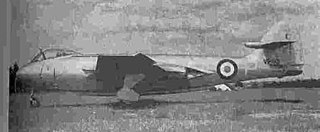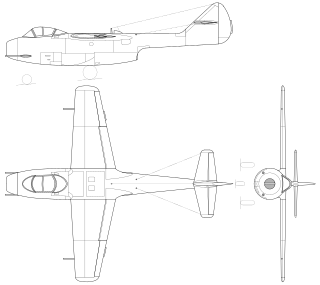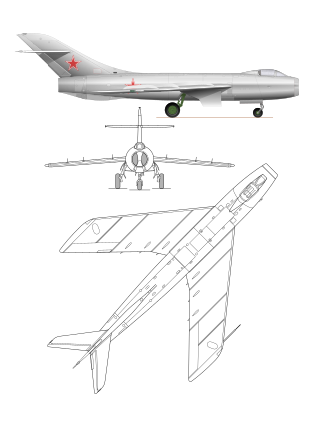Operators
 People's Republic of China
People's Republic of China
| BA-5 | |
|---|---|
| General information | |
| Type | Target drone |
| National origin | People's Republic of China (PRC) |
| Manufacturer | Shenyang Aircraft Manufacturing Factory |
| Primary user | PLAAF (People's Liberation Army Air Force) |
| History | |
| Developed from | Mikoyan-Gurevich MiG-15bis / J-2 - (Jianjiji-2) |
The Shenyang BA-5 was a target drone developed in the People's Republic of China, from Mikoyan-Gurevich MiG-15bis fighters withdrawn from manned use at the end of their service life.
Guidance and control equipment was installed in the cockpit in lieu of the ejection seat, with the BA-5 being used for the training of fighter pilots and surface-to-air missile crews.
Data from [1]
General characteristics
Performance
Avionics
Remote control / Radio command guidance equipment
Aircraft of comparable role, configuration, and era
Related lists

The Mikoyan-Gurevich I-250, aka MiG-13, was a Soviet fighter aircraft developed as part of a crash program in 1944 to develop a high-performance fighter to counter German turbojet-powered aircraft such as the Messerschmitt Me 262. The Mikoyan-Gurevich design bureau decided to focus on a design that used something more mature than the jet engine, which was still at an experimental stage in the Soviet Union, and chose a mixed-power solution with the VRDK motorjet powered by the Klimov VK-107 V12 engine. While quite successful when it worked, with a maximum speed of 820 km/h (510 mph) being reached during trials, production problems with the VRDK fatally delayed the program and it was canceled in 1948 as obsolete.

The Shenyang J-5 is a Chinese-built single-seat jet interceptor and fighter aircraft derived from the Soviet Mikoyan-Gurevich MiG-17. The J-5 was exported as the F-5 and was originally designated Dongfeng-101 and also Type 56 before being designated J-5 in 1964.

The Mikoyan-Gurevich I-270 was a response to a Soviet Air Forces requirement in 1945 for a rocket-powered interceptor aircraft for the point-defence role. In concept and basic configuration, it was related to the early Korolyov RP-318 rocket-powered aircraft which was developed in 1936 and first flew February 20, 1940, and the more recent Bereznyak-Isayev BI-1 Soviet design. Only two prototypes were built, both of which were destroyed in crashes, leading to the cancellation of the project.
The Rikugun Ki-202 Shūsui-Kai was a direct development of the German Messerschmitt Me 163 Komet rocket-powered interceptor aircraft. None were produced before Japan's surrender that ended World War II.

The Hawker P.1072 was a 1949 experimental British aircraft acting as a test bed for the Armstrong Siddeley Snarler rocket booster engine. It was the prototype Hawker Sea Hawk modified to install the rocket in the tail.
The PZL TS-16 Grot (Arrowhead) was a supersonic Strike aircraft and military jet trainer designed in Poland by Tadeusz Sołtyk. It is the first jet made without any foreign support from the East, and its creation was received very coldly by both the Kremlin and by the West. The project was started in 1958, but was canceled in 1964 for political pressure by USSR, before production could start. Despite this, a mockup designated TS-16RD was built. The RD version was expected to use Soviet RD-9B engine from the MiG-19 although an indigenous powerplant called the SO-2 was also in development for the final version. The production version was to have two engines, although the TS-16RD prototype that was built had only one.

The Yakovlev Yak-25 was a Soviet military aircraft, an early turbojet-powered fighter aircraft designed by the Yakovlev OKB. The designation was later reused for a different interceptor design. Tasked by the Council of Ministers in a directive issued on 11 March 1947, with producing a straight winged fighter similar to the earlier Yak-19, but powered by a Rolls-Royce Derwent V, OKB-115 swiftly produced the Yak-25, which blazed several trails as the first Soviet fighter with a fully pressurised cockpit, air conditioning, jettisonable canopy, and hydraulic airbrakes on the fuselage amongst other innovations.

The Beriev Be-2500 Neptun is a super heavy amphibious transport aircraft that, as of 2007, was in design and development by Russian design firm Beriev. The maximum takeoff weight is estimated at 2500 tons, hence its name.

The Lavochkin La-150, was designed by the Lavochkin design bureau (OKB) in response to a 1945 order to build a single-seat jet fighter using a single German turbojet. By this time both the Americans and British, as well as the Germans, had already flown jet fighters and the single Soviet jet engine under development was not yet ready for production. The design was completed quickly, but the construction of the five flying prototypes was protracted by the factory's inexperience in building metal aircraft. The aircraft made its first flight in September 1946, but proved to require extensive modifications to meet the Soviet Air Forces' requirements. These took so long to make and test that the aircraft was essentially obsolete by the time that they were completed. Even one variant with a much more powerful engine was inferior to other aircraft that the OKB had under development and all work was terminated in 1947.
The Sukhoi Su-10 or Izdeliye Ye was a Soviet turbojet-powered bomber aircraft built shortly after World War II.
The Sukhoi Su-5 or I-107 was a Soviet mixed-power prototype fighter aircraft built toward the end of World War II.

The Sukhoi Su-15 was a prototype Soviet all-weather interceptor which never reached production.

The Sukhoi Su-17 was a prototype Soviet fighter. The name was later reused for an entirely different fighter-bomber, see Sukhoi Su-17.

Yakovlev Yak-50 was an early experimental turbojet interceptor aircraft designed in 1948 by the Yakovlev OKB in the USSR. The aircraft was essentially a stretched version of the Yakovlev Yak-30 (1948), with a more powerful engine and greater wing sweep. The Yak-50 is perhaps most significant as the first Yakovlev aircraft equipped with velosipednoye (bicycle) landing gear, a trademark of later Yakovlev designs. The Yak-50 designation was later reused for a propeller-driven aerobatic and trainer aircraft.

The Caproni Vizzola C22 Ventura was a light jet-powered aircraft developed in Italy for use as a military trainer. It was of conventional sailplane configuration and bore a family resemblance to the Caproni Calif gliders, although the Ventura had an almost entirely metal structure. The student and instructor sat side by side under an expansive canopy, and weapons hardpoints were provided under each of the slender, high-mounted wings. It had retractable, tricycle undercarriage.

The Il-54 was a transonic bomber developed in the USSR in the 1950s. Only two examples were built before the project was abandoned.
The Ilyushin I-21,, also known as TsKB-32, was a single-engined, single-seat fighter produced in the USSR in 1936-7 in response to a government specification.

The Yakovlev Yak-1000 was a Soviet supersonic technology demonstrator intended to evaluate the aerodynamic layout and field performance of the cropped delta wing discussed in captured German documents in combination with the new Lyulka AL-5 turbojet. The tandem undercarriage proved to be unsatisfactory and there were serious flight stability problems related to the delta wing, enough so that it never flew after an accident during taxiing tests.

The Aeroprakt A-28 Victor is a Ukrainian light aircraft, designed and produced by Aeroprakt of Kyiv. The aircraft is supplied as a complete ready-to-fly-aircraft.
The Mikoyan-Gurevich I-350, was a Soviet Cold War-era experimental fighter aircraft. It was the first Soviet aircraft able to maintain supersonic speed.